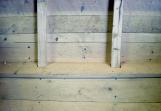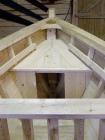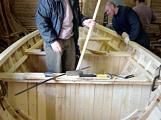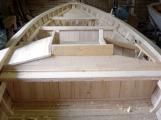20
Shoots (cross-beam floor boards in the standing rooms) were attached across the keel and timbers on the bottom of the boat.
21
Ceilings
2003
Winterton Boat Building and Community Museum, Newfoundland and Labrador, Canada

22
In the mid-ship room, located at the center of the boat, ceilings (floor boards running lengthwise) were installed. This area was used for holding fish.
23
Bevel gauge
2003
Winterton Boat Building and Community Museum, Newfoundland and Labrador, Canada

24
An adjustable bevel was an essential tool especially for determining angle cuts when fitting inside ceilings and shoots.
25
The cuddy
2003
Winterton Boat Building and Community Museum, Newfoundland and Labrador, Canada

26
A small, decked compartment, called a cuddy, was built behind the stem for storage of things that needed to be kept dry.
27
Bulkheads are installed
2003
Winterton Boat Building and Community Museum, Newfoundland and Labrador, Canada

28
Bulkheads (vertical boards) were installed under the thwarts.
29
Boring the shaft hole
2003
Winterton Boat Building and Community Museum, Newfoundland and Labrador, Canada

30
A shaft hole was bored into the bottom of the stern post using an auger. The propeller shaft was installed using an outside stuffing box (watertight coupling through which the shaft could rotate).
31
Auger
2003
Winterton Boat Building and Community Museum, Newfoundland and Labrador, Canada

32
The auger was a very useful tool in the traditional boat building process as it was used to bore shaft holes and holes needed to bolt pieces of the boat together.
33
Engine house
2003
Winterton Boat Building and Community Museum, Newfoundland and Labrador, Canada







